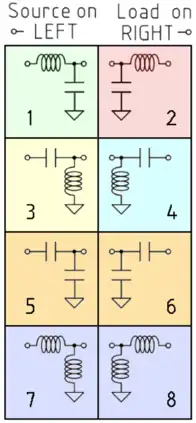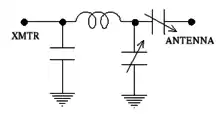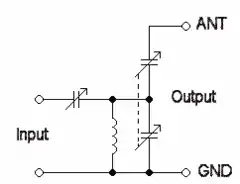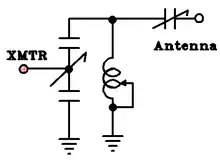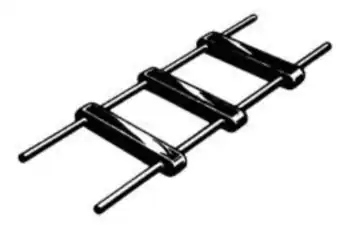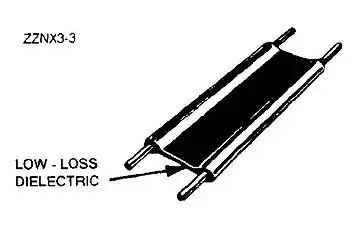Antenna tuner
An antenna tuner is an electronic device inserted into the feedline between a radio transmitter and its antenna. Its purpose is to optimize power transfer by matching the impedance of the radio to the signal impedance at the end of the feedline connecting the antenna to the transmitter.
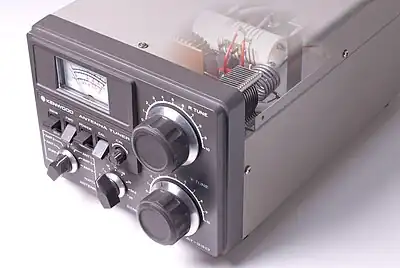
Various alternate names are used for this device: antenna matching unit, impedance matching unit, matchbox, matching network, transmatch, antenna match, antenna tuning unit (ATU), antenna coupler, feedline coupler. English language technical jargon makes no distinction between the terms.[lower-alpha 1]
Antenna tuners are particularly important for use with transmitters. Transmitters are typically designed to feed power into a reactance-free, resistive load of a specific value: Essentially all radio transmitters built after the 1950s are designed for 50 Ω (Ohm) output.[1][lower-alpha 2] However the impedance of any antenna normally varies, depending on the frequency and other factors, and consequently changes the signal impedance that appears at the other end of the feedline, where the line connects to the transmitter. In addition to reducing the power radiated by the antenna, an impedance mismatch can distort the signal, and in high power transmitters may overheat either the amplifier or the cores of transformers along the line.[lower-alpha 3]
To avoid possible damage resulting from applying power into a mismatched load, and prevent self-protection circuits in the amplifier from cutting back the power output, matching networks are a standard part of almost all radio transmitting systems.[lower-alpha 4] The system transmatch may be a circuit incorporated into the transmitter itself, a separate piece of equipment connected to the feedline anywhere between the transmitter and the antenna, or a combination of several of these. In transmitting systems with an antenna distant from the transmitter and connected to it by a transmission line (feedline), in addition to a matching unit where the feedline connects to the transmitter, there may be a second matching network (ATU) to bridge the transmission line impedance over to the antenna's feedpoint impedance, either as a separate unit mounted near the antenna, or as a configuration of extra metal segments incorporated into the antenna's feedpoint.
Overview
Antenna tuners are particularly important for use with transmitters. Transmitters are designed to feed power into a resistive load of a specific value: 50 Ω (Ohms), by modern convention.[1][lower-alpha 2] If the impedance seen by the transmitter departs from this design value due to improper tuning of the combined feedline and antenna, overheating of the transmitter's final stage, distortion, or loss of output power may occur.[lower-alpha 3]
Use with transmitters
Antenna tuners are used almost universally with solid-state transmitters. Without a matching system, in addition to reducing the power radiated by the antenna, the reflected (or "backlash") current can cause signal distortion and overheat transformer cores. In high-power transmitters it may overheat the transmitter's output amplifier.[lower-alpha 3] When excessive reflected power is detected, self-protection circuits in modern transmitters automatically reduce power to safe levels, and hence reduce the power of the signal leaving the antenna even more than the loss from some of the power being reflected away from the antenna.
- Automatic power reduction by safety circuits typically causes most of the power loss (see below).
Because of this, feedline matching is a standard part of almost all radio transmitting systems. The transmatch might be a circuit incorporated into the transmitter itself,[lower-alpha 4] or a separate piece of equipment connected between the transmitter and the antenna. In transmitting systems with an antenna separated from the transmitter and connected to it by a long transmission line (feedline), there may be another matching network (ATU) at the antenna that matches the transmission line's impedance to the antenna.
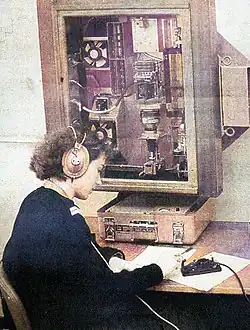
Narrow-band transmitters like cell phones and walkie-talkies have a built-in matching circuit, permanently set to work with the installed antenna.[lower-alpha 4] In multi-frequency communication stations like amateur radio stations, and for multi-kilowatt transmitters needed for wide-area AM stations, the ATU is adjustable to accommodate changes in frequency, in the transmitting system, or to its environment.[lower-alpha 5] Instruments such as SWR meters, antenna analyzers, or impedance bridges are used to measure the degree of match or mismatch. Testing to ensure the transmitter is correctly matched to the signal on the feedline is needed after any change that might perturb the system.
High power transmitters like radio broadcasting stations have a matching unit that is adjustable, to accommodate changes in the transmit frequency, the transmitting unit, the antenna, or the antenna's environment.[lower-alpha 5] Adjusting the ATU to match the transmitter to the antenna is an important procedure which is done after any work on the transmitter or antenna occurs, or any drastic change in the weather affecting the antenna, such as hoar frost or dust storms.
The effect of this adjustment is typically measured using an instrument called an SWR meter, which indicates the aggregate mismatch between a reference impedance (which should be the same as the transmitter: 50 + j 0 Ω[lower-alpha 2]) and the complex signal impedance at the point on the feedline where the SWR meter is inserted. Other instruments, such as antenna analyzers or impedance bridges provide more detailed information, most importantly the separate mismatches of the signal's resistive and reactive parts of the impedance on the input and output sides of the ATU.
What an "antenna" tuner actually tunes
Despite its name, an "antenna" tuner does not actually tune the antenna: Actual 'tuning' of an antenna involves adjusting its length, or attaching extra segments to add capacitance or inductance to the path of currents through it, in order to eliminate reactance at the antenna feedpoint for the 'tuned' frequency.[lower-alpha 6] Instead, an antenna "tuning" unit matches the signal's complex resistive + reactive impedance presented at the end of the feedline (sometimes very far from the antenna feedpoint) to the reactance-free, purely resistive (real) impedance required at the transmitter output connection, and in the same step, raises or lowers the signal resistance to the level required by the transceiver (usually 50 Ω, by arbitrary[lower-alpha 2] convention).
If both the tuner and the feedline were ideal – lossless, or resistance-free – then tuning at the transmitter end would indeed produce a perfect match at every point in the transmitter-feedline-antenna system.[7] However, for realistic feed systems, lossy feed lines limit the ability of the antenna tuner to remotely compensate for the signal frequency being different from the antenna's resonant frequency.[8]
The feedline power loss will be low if the line length between the transmitter and the antenna is short, or if it has very low DC resistance per meter of length, or if it is built to carry power primarily as high voltage and low current (high impedance: at least 300 Ω = 300 volts pushing through every / 1 ampere of current flow ). When feedline power loss is very low, a tuner at the transmitter end of the line can indeed produce a worthwhile degree of (imperfect) matching and tuning throughout the whole antenna and feedline network.[9][10] However that is not the case when a lossy and low-impedance feedline is used – like common 50 or 75 Ω coaxial cable (low impedance: low voltage and high current).[8] For low-impedance line, maximum power transfer occurs only if matching is done at the antenna, in conjunction with a matched transmitter and feedline, producing a match at both ends of the line and every point in between.
In any case, regardless of where they may be placed or how many there are, one or several matching units do not alter the gain, efficiency, or directivity of any one antenna, nor can they change the internal complex impedances within the parts of that antenna itself, nor the impedance presented at the antenna's feedpoint.
Use in receivers
ATUs are not widely used in shortwave receivers, and almost never used in mediumwave or longwave receivers. They are, however, helpful for receivers operating in the upper shortwave (upper HF), and are needed for VHF and higher.
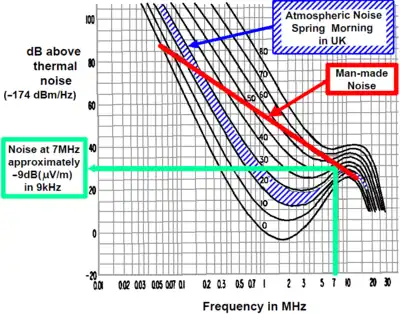
At the antenna, if the end of the transmission line connected to the antenna is not a conjugate match to the antenna's feedpoint impedance, a part of any intercepted signal will be trapped inside the antenna, eventually to be radiated back out. Similarly, at the receiver, if the complex signal impedance at the receiver end of the transmission line is not a match to the receiver's input connection, then some of the incoming signal will be reflected back to the antenna, and not enter the receiver. However, the loss of signal power is only important for frequencies at and above the middle HF band.
In radio receivers working below roughly 10~20 MHz, atmospheric radio noise dominates the signal-to-noise ratio (SNR) of the incoming radio signal, and the power of the atmospheric noise that arrives with the signal is far greater than the insignificantly small contribution by inherent thermal noise generated within the receiver's own circuitry. Therefore, the receiver can freely amplify the weak signal to compensate for any antenna system inefficiencies caused by impedance mismatches, without perceptibly increasing noise in the output.
In contrast, at higher frequencies the ionosphere no longer traps radio waves inside the atmosphere, and bothersome noise radiates away into space, leaving the higher frequencies naturally noise-free.[lower-alpha 7] In the upper HF, VHF, and higher frequencies, receivers encounter very little atmospheric noise, and the noise added by the receiver's own front end amplifier dominates the SNR. At frequencies above about 10~20 MHz the internal circuit noise is the factor limiting sensitivity of the receiver for weak signals.
So as the receive frequency rises, it becomes increasingly important that at the antenna end of the transmission line, the receiving antenna's complex output impedance be conjugately matched to the feedline's characteristic impedance, and likewise the signal impedance at the receiver end of the transmission line be matched to the receiver input connection: Matching impedances at every step along the way transfers the maximum possible power from any weak signal arriving at the antenna into the first amplifier, to try to provide the front end amplifier with a signal significantly louder than the amplifier's own internally-generated noise.
For that reason, either impedance-matching circuits or impedance-matched antennas are incorporated in some receivers for the upper HF band, such as 'deluxe' CB radio receivers, and for most VHF and higher frequency receivers, such as FM broadcast receivers, and scanners for aircraft and public safety radio.
Broad band matching methods
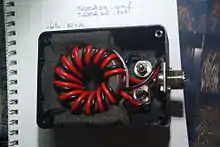
Strictly speaking, transformers, autotransformers, and baluns are not complete impedance matching units: Even though they do transform the magnitude of impedances, they are not themselves able to bridge mismatched phases, and so are unable to produce a full conjugate match. Nonetheless, transformers of these types are frequently incorporated into antenna feed systems to convert between balanced and unbalanced cabling, or seamlessly join different cabling impedances, providing an impedance match in the special case of reactance-free antenna feed systems. They are also sometimes used to augment the operation of the narrow band antenna tuner designs (discussed in following sections) since they can widen the range of impedances that an antenna tuner can match.
Transformers and baluns are usually designed with coil windings that have the minimum inductance needed to function, to ensure that any inadvertent reactance they contribute has only a small effect on the resonant frequency of either the antenna or narrow band transmitter circuits. This results in a trade-off, since at lower frequencies the coupling between the two sides of a transformer may not be strong enough, and at higher frequencies the stray reactance may be too much to ignore. Although these high and low frequency problems constrain the useful bandwidth of the devices, they nevertheless are typically extremely broadbanded compared to any other method of impedance matching.
Ferrite transformers
Solid-state power amplifiers operating from 1–30 MHz typically use one or more wideband transformers wound on ferrite cores. MOSFETs and bipolar junction transistors typically used in modern radio frequency amplifiers are designed to operate into a low impedance, so the transformer primary typically has a single turn, while the 50 Ω secondary will have 2 to 4 turns. This design of feedline system has the advantage of reducing the retuning required when the operating frequency is changed.
A similar design can match an antenna to a transmission line: For example, many TV antennas have a 300 Ω impedance but feed the signal to the TV through a 75 Ω coaxial line. A small ferrite core transformer makes the broad band impedance transformation. This transformer does not need, nor is it capable of adjustment. For receive-only use in a TV the small SWR variation with frequency is not a significant problem.
Ferrites are ceramics that are insulators for electric current, but very effective conductors of magnetic fields. Unlike the clays used to make pottery, ferrite ceramics are made from iron oxides (rust) and a varying smaller proportion of either manganese, nickel, zinc, or tin, "spiced" with trace amounts of various other metals and their oxides. Different mixtures are blended for particular frequency ranges, normally one to several megahertz wide. Each mix becomes less effective at frequencies higher or lower than its intended range, and this in turn imposes further practical bandwidth limits on ferrite transformers.
Many ferrite transformers are configured to perform a balanced-to-unbalanced transformation in addition to the impedance change. When the balanced to unbalanced function is present these transformers are called a balun (otherwise an unun). The most common baluns have either a 1:1 or a 1:4 impedance transformation.[lower-alpha 8]
Autotransformers
There are several designs for impedance matching using an autotransformer, which is a simple, single-coil transformer with different connection points or taps spaced along the coil windings. They are distinguished mainly by their impedance transform ratio,[lower-alpha 8] and whether the input and output sides share a common ground, or are matched from a cable that is grounded on one side (unbalanced) to an ungrounded (usually balanced) cable. When autotransformers connect balanced and unbalanced lines they are called baluns, just as two-winding transformers are.[lower-alpha 9]
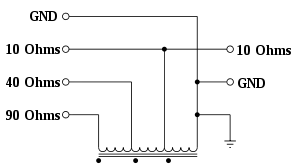
The circuit pictured at the right has three identical windings wrapped in the same direction around either an "air" core (for very high frequencies) or ferrite core (for middle frequencies) or a powdered-iron core (for very low frequencies). The three equal windings shown are wired for a common ground shared by two unbalanced lines (so this design is an unun), and can be used as 1:1, 1:4, or 1:9 impedance match, depending on the tap chosen.[lower-alpha 10]
For example, if the right-hand side is connected to a resistive load of 10 Ω, the user can attach a source at any of the three ungrounded terminals on the left side of the autotransformer to get a different impedance. Notice that on the left side, the line with more windings between the line's tap-point and the ground tap measures greater impedance for the same 10 Ω load on the right.
Narrow band vs. broad band matching methods
Antenna matching methods that use transformers, described above, tend to cover a wide range of frequencies. The "narrow band" tuned circuit methods described below all cover a very much smaller span of frequencies, by comparison.
For example, a single, very well-made, commercially available balun can cover frequencies from 3.5 to 29.7 MHz – a span over 26 MHz wide, or nearly the entire HF band. In contrast, matching a feedline to an antenna using a cut segment of transmission line (as described below) is perhaps the most efficient of all matching techniques, in terms of electrical power, but typically can only cover a range of about 3.5~3.7 MHz wide in the HF band – a very small range indeed: The 26.2 MHz bandwidth of the example balun is a more than 7 times wider span of frequencies.
Antenna coupling or feedline matching networks also have narrow bandwidth for any single setting, but are built with variable components so they can be conveniently retuned – some modern transmatches can even automatically self-retune whenever the transmit frequency changes. A few amateur operators over-react to horror stories of wrongly adjusted transmatches, whose maladjustment causes high loss.[11][12] However, in terms of power-loss, even ignoring the loss exaggerations, circuit-based matching networks are perhaps the least efficient means of matching (aside from having no impedance matching at all!).
Transmission line antenna tuning methods
There are two different ways to match-up different impedances using sections of feedline: Either the original feedline can have a deliberately mismatched section of line spliced into it (called section matching), or a short stub of line can branch off from the original line, with the stub's end either shorted or left unconnected (called stub matching). In both cases, the location of the section of extra line on the original feedline and its length require careful placement and adjustment, which is essentially certain to work for only one desired frequency.
Section matching
A specially chosen length of transmission line spliced into the main feedline can be used to match the main line to the antenna, if the spliced section's characteristic impedance is different from that of the main feedline at either end. Basically, the technique is to fix a mismatch by creating a carefully contrived opposite mismatch: A line segment with the proper impedance and proper length, inserted at the proper distance from the antenna, can perform complicated matching effects with very high efficiency. The drawback is that matching with line segments only works for a very limited frequency range for which the segment's length and location are appropriate.[3](p 22‑24)
The 1/ 6 wavelength coaxial transformer is a useful way to match 50 to 75 Ω using the same general method.[13][14]
- Example
- A simple example of this method is the quarter-wave impedance transformer formed by a section of mismatched transmission line. If a quarter-wavelength of 75 Ω coaxial cable is linked to a 50 Ω load, the SWR in the 75 Ω quarter wavelength of line can be calculated as 75 Ω/ 50 Ω = 1.5 , when there is no reactance; the quarter-wavelength of line transforms the mismatched impedance to 112.5 Ω ( 75 Ω × 1.5 = 112.5 Ω ). Thus this inserted section matches a 112 Ω antenna to a 50 Ω main line.
Stub matching
A second common method is the use of a stub: Either a shorted or open section of line is connected in parallel with the main feedline, forming a dead-end branch off the main line.[lower-alpha 11] The stub can be any impedance: Unlike section matching, above, there is no need for it to be different from the main line. A stub less than a quarter-wave long whose end is short-circuited subtracts susceptance from the line, functioning as an inductor; if its end is left open (unconnected) then the stub adds susceptance, functioning as a capacitor.[15][lower-alpha 12]
The stub is placed at one of the points along the main line where, at the desired frequency, the signal impedance's oscillating resistive part happens to match the characteristic impedance of the feedline. The length of the stub is chosen so that at that frequency, its susceptance is equal-and-opposite to the unwanted signal susceptance at the connection point. The combined effect of a proper location and correct length removes the susceptance from the signal (and hence removes the reactance that corresponds to the susceptance) and leaves the resistance of the signal matched to the of the feedline impedance beyond the connection point, eliminating any SWR from that point onward.[15]
By way of example, both the J-pole antenna and the related Zepp antenna are examples of antenna designs with a built-in stub match at the antenna feedpoint.
More elaborate stub matching methods involve using two stubs, either in series or in parallel, to create an L‑C tuning circuit, some of which are electrically equivalent to ‘L’ networks, described in the following sub-sections.

Basic two-element ‘L’-network
The most basic form of lumped circuit matching is with the ‘L’-network: It is the simplest circuit that will achieve the desired transformation, and always consists of exactly two reactive components. The ‘L’ circuit is important not only in that many automatic antenna tuners use it, but also because more complicated circuits can be analyzed as chains of ‘L’-networks, as will be shown in later sections, in descriptions of larger tuning circuits.
For any one given load and frequency, one must use a circuit from one of the eight possible configurations shown below.
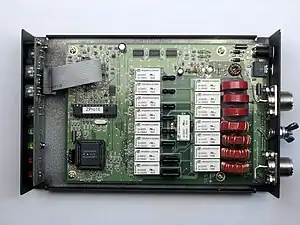
Commercially available automatic antenna tuners most often are ‘L’-networks, since they involve the fewest parts, and have a single unique match setting, so just one target for the automatic self-adjustment circuitry to seek.

.svg.png.webp)
This circuit is called an "ell" network, not because it contains an inductor (customary symbol ) (in fact some ‘L’-networks consist of two capacitors), but instead because of the shape: In the schematic, the two components are at right angles to each other, in the shape of a Latin letter ‘L’ either rotated (┬─) or flipped and rotated (─┬). The basic circuit required when pairs of lumped capacitors and / or inductors are used is shown in the chart of schematics below.
The ‘T’ ("tee") network and the ‘π’ ("pie" / "pee") network also have their parts laid out in a shape similar to the Latin and Greek letters they are named after: The ‘T’ network is electrically equivalent to two back-to-back ‘L’ networks, since ─┬ ┬─ ≅ ─┬┬─ ≅ ─┬─ ≅ ‘T’ ; the ‘π’ network is equivalent to two nose-to-nose ‘L’ networks, e.g. ┬─ ─┬ ≅ ┬─┬ ≅ ‘π’ . (See the individual ‘π’ and ‘T’ network descriptions below for more detail.)
‘L’-network math
This basic network is able to act as an impedance transformer. If the output has an impedance consisting of resistive part Rload and reactive part Xload, which add to make a single complex number The input is to be attached to a source which has an impedance of Rsource resistance and Xsource reactance, then
and
- .
In this example circuit, XL and XC could be swapped. All the ATU circuits below create this network, which exists between systems with different impedances.
For instance, if the source has a resistive impedance of 50 Ω and the load has a resistive impedance of 1000 Ω :
If the frequency is 28 MHz, because
get,
So,
And because
get
‘L’-network theory and practice

A parallel network, consisting of a resistive element (1000 Ω) and a reactive element (−j 229.415 Ω), will have the same impedance and power factor as a series network consisting of resistive (50 Ω) and reactive elements (−j 217.94 Ω).
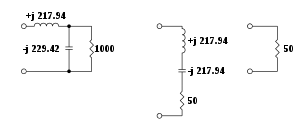
By adding another element in series (which has a reactive impedance of +j 217.94 Ω), the impedance is 50 Ω (resistive).
Types of ‘L’ networks and their uses
There are eight different configurations of components for an ‘L’ network, which are shown in the left and middle columns of the diagrams at the right, marked with numbers 1–8 with corresponding colors. The right column is three versions of the same Smith chart, showing antenna resistance (R) increasing toward the right on the horizontal axis, with the conventional 50 Ohms at the center point. Antenna reactance varies along vertical direction, with increasing inductive reactance (XL , conventionally positive) going upward from the big circle's center-line, and capacitive reactance (XC , conventionally negative) increasing going downward. The horizontal line cutting through the middle of the large circle is reactance-free.[lower-alpha 13]
Network selection
If a load impedance is plotted on a Smith chart, it will fall into one of the four regions shown: Upper half-labrys (rounded axe head) , lower half-labrys , left inner-circle ∘ ⃝ and ∘ ⃝, and right inner-circle ◯⃘ and ◯⃘.[16] For a complex impedance falling anywhere in the chart, either two, or four different ‘L’ networks may be used, so the user may choose other criteria to decide which of the two or four networks to use. Impedances falling into either of the two inner circles, ∘ ⃝ (and ∘ ⃝) or ◯⃘ (and ◯⃘), can be matched by two different ‘L’ networks (high pass and low pass), and each of the half-labryses, and , allows four.
Each region is color coded as well as marked with corresponding numbers to indicate which networks can be used to match an impedance in that region. For example, an impedance that falls within the right inner circle (either green, ◯⃘, or yellow, ◯⃘, labeled "R > 50") can be matched using networks 1 or 3.[lower-alpha 14][lower-alpha 13]
"Step up" and "step down" configurations
The two columns of networks are called "step down" (left) and "step up" (middle). The sense of the metaphorical "step" is always from the antenna to the radio; in all the diagrams in this article, that direction is right to left.[lower-alpha 15]
- All the ─┬ shaped networks are in the left column, marked with odd numbers, are "step down" networks: The series resistance value coming from the antenna, that goes into connection at the right, is transformed to a lower parallel resistive part going into the radio connection on the left.
- All the ┬─ shaped networks in the middle column, marked with even numbers, are "step up": The parallel or "shunt" resistance, that goes in on the antenna-side connection on the right, is transformed up to a higher series resistance coming out at the radio connection on the left.
Although in most electronics it is typically a mistake to compare a series resistance to a parallel resistance, in this special case it works out to be correct.
Because the radio has no reactance (and no susceptance) its series and parallel resistances are the same. So for these rules about orienting an ‘L’ network, the radio side is always 50 Ω, regardless of whether it is connected to the series or parallel side of the network. If the description above, or a rule below, calls for using a series or parallel resistance on the radio side, it's 50 Ω, whichever. However, on the antenna side, they are usually different: If the antenna's impedance has any reactance in it (or equivalently, its admittance has any susceptance in it), then the parallel resistance will be higher than the series resistance; for choosing the orientation it matters that the correct resistance value on the antenna side is considered. (The parallel form of resistance is always a larger number than the series form. The formulas in the follow-on section may be used to convert between them.)
Despite the fact that it usually makes no sense to compare parallel and series resistance values, compare the radio's 50 Ω to antenna's series or parallel resistance, to which ever way is opposite sense of the side of the ‘L’ network that is to be connected to the antenna. There are multiple different ways to remember how to work out which ‘L’ network orientation to use. Here are a few. Pick a rubric that's easiest for you to remember:
- If the antenna's series resistance is higher than 50 Ω, it should connect to the parallel element (the vertical leg, sticking down towards ground); if the antenna's parallel resistance is lower than 50 Ω, it should connect to the series element (the pointy, horizontal side).
- For orienting the network, the resistance compared on the side with the series element is always the parallel resistance – the opposite of the network's series element it is connecting to. The resistance compared on the side with the network's parallel element is the series resistance – similarly opposite.
- In both cases, the "shunt" or parallel element (the vertical element, called the "back side" in tuner circuit descriptions, below) is on the side with the higher series resistance. The series element (the horizontal, or "pointy noze" end) connects to a parallel resistance whose number value is higher than the series resistance on the opposite side.
- If one thinks of the ‘L’ shape as looking like a finger ( ☜ ─┬ and ☞ ┬─ ), then the finger points from series to parallel resistance, from high to low: The network points towards the parallel resistance whose value is the lower number, compared to the side it points away from which has a series resistance whose value is the higher number.
Measuring instrument limitations
Commonly used SWR meters do not indicate complex impedance, so they are not very helpful for determining which of the ‘L’ networks can be used for the needed match. Antenna analyzers, however, can separately show the resistive and reactive parts of the antenna impedance, and are suitable for selecting the orientation of an ‘L’ network. The most convenient of these analyzers are able to switch back and forth between series and parallel representation, and are also able to plot the antenna's complex impedance on a Smith chart display, which can then be compared to the network schematics and corresponding Smith charts shown above.
If an instrument indicates the complex series impedance, but not the shunt (parallel) equivalent, then a programmed hand calculator or spreadsheet, or an online calculator[17] or the formulas[18] shown below can be used to make the conversion to the parallel values.[lower-alpha 16] The formulas for calculating the series or parallel (shunt) impedance in the mandatory case that neither of the resistances (R) is zero, the usual case when neither of the reactances (X) is zero are as follows:
If either or is not zero, then both are the same type of reactance: Either both capacitive or both inductive. If that is kept in mind, one can dispense with sign conventions; however, the standard convention is to make capacitive reactances negative, and in that case the value of will also be negative.
In the special case when the series reactance then The middle row of the resistance formulas remains good: They show that the series and parallel resistances become the same. However, when the bottom row's left formula for the parallel reactance from the series reactance fails (becomes singular – divide by zero error). The answer can be resolved another way, by recognizing the trend as gets smaller (closer to actually being zero): The parallel reactance becomes so large it blocks all current, as if it was not connected (nominally infinite, or an open circuit); the series reactance formula still works, and the series reactance vanishes, becoming a simple conducting wire (nominally zero, or a short-circuit).
The unrealistic case where either resistance is zero is not even of academic interest: Any antenna with zero total resistance is non-functional (see radiation resistance).
Additional selection criteria

Networks 1–4, shown in the top two rows, use one inductor and one capacitor; the pair with a series inductor (1 ┬─ and 2 ─┬ ) are low-pass; the next two, with the capacitor in series (3 ┬─ and 4 ─┬) are high pass. Cusomarilly, low-pass has been preferred with a transmitter, to attenuate possible harmonics above the match frequency. The high-pass configuration shown in the second row, (3 and 4) may be chosen if the required component values are more convenient, or if the radio already contains a good, internal low-pass filter, or if attenuation of low frequencies is desirable.[lower-alpha 18]
In some cases it may be desirable that the network either pass through DC currents used for power feed to devices on the antennas, such as relay switches, or to block DC used for those devices from reaching the transmitter. Thus, the series (horizontal) component should be either an inductor (L) to pass DC, or a capacitor (C) to block DC. In addition, it may be useful for the phase shift across the network to be either advanced or delayed (see below).

Automatic and manual ‘L’ networks often use either network 1 or 2.[lower-alpha 19] Many commercial tuners include a simple SPDT switch that connects the vertical (shunt, C) component to either the left or right side of the horizontal (series, L) component, making both networks 1 ┬─ and 2 ─┬ available with the same transmatch[19] (see schematic, upper right). As shown by the green and red sections of the top Smith chart, these two networks can together handle all possible loads.[lower-alpha 17] Likewise, the yellow and blue parts of the middle Smith chart show that one of either network 3 or 4 (schematic, lower right) can match any load.[lower-alpha 17]
- Small loop example
- Loads such as a small transmitting loop may be highly inductive. The impedance will fall well into the region of the Smith chart dominated by inductive reactance (orange shaded upper half-labrys, , labelled "L dominant"). In addition to networks 1 and 4, they can use the low-loss all-capacitor networks 5 or 6.[lower-alpha 20]
- Short whip example
- Short vertical antennas such as used for HF mobile, are dominated by capacitive reactance (purple shaded lower half-labrys, , labelled "C dominant"), in addition to networks 2 and 3, they can be easily matched with inductor-only networks 7 or 8, which is similar (but not identical) to connecting two taps onto a single grounded coil at the base of the whip.
Q and phase shift
Unlike the more complicated networks, described below, the ‘L’ network does not allow independent choice of operating Q, nor phase shift. High Q implies less loss, but also narrow operating bandwidth. ‘L’ network Q is fixed at the geometric mean of the input and output impedances, hence it is greater when the impedances to be matched are greatly different.
Phase shift can be made to either lead or lag by choosing an alternate network, but like the Q, for ‘L’ networks its value is fixed by the impedance ratio, and odds are that none of the two or four possible networks will provide both a desired phase shift and the right impedance match with the same setting. However, transmitting from a single antenna does not require shifting the phase: Phase shift is only important if two or more loads are to be fed, such as the arrays of mast antennas used by many high-power AM broadcasters.[6](p 1211)
Three-component unbalanced tuners
In contrast to two-element ‘L’ networks, the circuits described below all have three or more components, and hence have many more choices for inductance and capacitance that will produce an impedance match, unfortunately including some bad choices.[11] The two main goals of a good match are:
- to minimize losses in the matching circuit, and
- to maximize bandwidth – e.g. the widest span of frequencies that are matched tolerably well.
To obtain good matches and avoid bad ones, with every antenna and matching circuit combination, the radio operator must experiment, test, and use judgement to choose among the many adjustments that match the same impedances (see the maximum capacitance rule below).
All of the designs with three or more elements also allow a somewhat independent choice of how much the phase is shifted by the matching unit.[21] Since phase matching is an advanced topic, mainly of use for multi-tower broadcast arrays, it is omitted here for brevity. A good summary of phase change by matching networks is given in the Antenna Engineering Handbook[5] and the NAB Engineering Handbook.[6]
All of the matching networks in this section can be understood as composites of two ‘L’ networks. The descriptions for each network below break down the network into its component ‘L’ networks from the chart in the prior section; although that design information may be 'nice to know', it is not 'need to know', and that part of the line matching network description may be skipped.
High-pass ‘T’ network
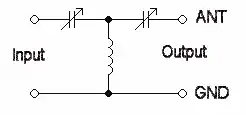
This configuration is currently popular because at shortwave frequencies it is capable of matching a large impedance range with capacitors in commonly available sizes. However, it is a high-pass filter and will not attenuate spurious radiation above the cutoff frequency nearly as well[11] as other designs (see the low pass ‘T’ network and ‘π’ network sections, below). Due to its low losses and simplicity, many home-built and commercial manually tuned ATUs use this circuit.[11] The tuning coil is normally also adjustable (not shown).
The ‘T’ network shown here may be analyzed as a high-pass step-down ‘L’ network on the input side feeding into a high-pass step-up ‘L’ network on the output side (─┬ ┬─). Like all ‘T’ networks, the internal impedance pattern is low ─┬ high ┬─ low: Impedance in the center is at least as high as the greater of the input and the output impedances, hence the voltage inside the network is at least as high as the highest of the voltages at its connections on either side. The two side-by-side vertical (shunt) inductors in the conjoined circuit are combined into an equivalent single inductor.
Low-pass ‘T’-network
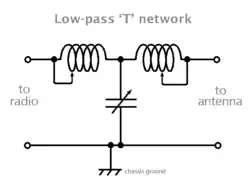
This configuration is popular for mediumwave transmitting systems, since it requires a shunt capacitor in commonly available sizes, whereas the high-pass form, if used at the same frequencies, would require exceptionally large capacitors in its series sections. Because it is a low-pass filter this network will effectively eliminate spurious harmonic radiation above its tuned frequency essentially equally as well as any other design, and AM broadcasters are liable to stricter surveillance and larger financial penalties for interference with other commercial stations' signals than amateurs operating in the shortwaves are.
Further, at medium frequencies (MF) the use of inductors as series elements is convenient in several ways: The left and right inductors, which may need to be roughly 10× larger than those used in HF circuits, are easily made by hand from commonly available copper tubing, and in the lower MF range, the nuisance resistive losses in the coil at HF are reduced by roughly 5~10 dB. Using inductors for the series elements is also preferable for MF, since feasible antennas tend to be short, and hence show bothersome capacitive reactance; the needed contrary reactance can be straightforwardly provided just by making the antenna-side inductor extra large.
Like the high-pass ‘T’ network in the prior section, this low-pass network may also be analyzed as a step-down ‘L’ network on the input side feeding into a step-up ‘L’ network on the output side (─┬ ┬─). The impedance pattern is again low ─┬ high ┬─ low, with as high or higher impedance / higher voltage in the center of the network than the highest of the connections on either side.
The two side-by-side capacitors from the two ‘L’ networks are merged in the conjoined network into a single capacitor with the same total capacitance. The only real distinction between the high-pass network above, and this low-pass design, is that in this network the placement of inductors and capacitors in the network is swapped.
Theory and practice
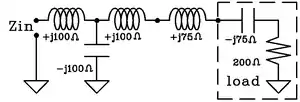
An example schematic for matching with the low pass ‘T’ network is shown at the right.
The load measures Zload = 200 Ω − j 75 Ω with 200 Ω (without j ) representing the real, resistive part, and −j 75 Ω the capacitively reactive part of the combined impedance Zload. Conceptually, the −j 75 Ω can be cancelled by adding a series inductor with +j 75 Ω reactance. Doing so leaves a purely resistive (real) 200 Ω to be matched to 50 Ω.
The resistance-matching is done with a circuit that mimics a 100 Ω Quarter wave impedance transformer, consisting of two inductors with +j 100 Ω reactance and a shunt capacitor with −j 100 Ω . The quarter wave-style transformer circuit uses equal and opposite reactances, each of which is the geometric mean of the two resistances to be matched:
The output inductor of the quarter wave network can be merged with the inductor used to cancel the reactance of the load, by replacing the pair with one inductor with the sum of the two inductances. The final network will have +j 100 Ω for the input inductor, −j 100 Ω for the capacitor and +j 175 Ω for the output inductor.
This quarter-wave-style solution will cause a phase shift of 90 degrees. If the output phase matters, then one of the many other possible solutions for the capacitance and two inductances can be used instead.[21] This solution uses a low pass configuration. Swapping the inductors and capacitors, and appropriately adjusting their reactances, would give a high pass configuration.
Low-pass ‘𝝅’ network
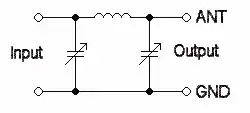
A ‘π’ (pi) network can also be used; it is the electrical conjugate[lower-alpha 21] of the low pass ‘T’ network shown in the prior subsection. This ATU has exceptionally good attenuation of harmonics, and was incorporated into the output stage of tube-based ‘vintage’ transmitters and many modern tube-based RF amplifiers. However, the standard ‘π’ circuit is not popular for stand-alone multiband antenna tuners, since the variable capacitors needed for the 160 m and 80 / 75 m amateur bands are prohibitively large and expensive.
The ‘π’ network shown here may be described mathematically as a low-pass step-up ‘L’ network on the input side feeding into a low-pass step-down ‘L’ network on the output side (┬─ ─┬). The impedance pattern is high ┬─ low ─┬ high, hence the interior impedance must be at least as low as the lowest of the input and output impedances: As low or lower impedance / high or higher current in the center, inside the network, as on either side. The two noze-to-noze inductors in the joined circuit are replaced with a single inductor with the same total inductance.
Drake's modified ‘π’ network
A modified version of the ‘π’ network is more practical as it uses a fixed input capacitor (left-most), which can be several thousand picofarads, allowing the variable capacitors (the two on the right) to be smaller. A band switch (not shown) sets the inductor and the left-side input capacitor (shown as fixed components in the schematic).[22] This circuit was used in tuners covering 1.8–30 MHz made before the popularity of the simpler ‘T’‑network, above.[23]
In all antenna tuner circuits each of the available adjustments affects both the reactive and resistive parts of the impedance match. Drake's modified ‘π’ network circuit is somewhat unusual in that regard: For a given setting of the band switch, the upper right, series capacitor mostly adjusts the reactive part of the impedance match, and the lower right, shunt capacitor mostly affects the resistive part of the impedance match. This makes it easier to estimate how to adjust the two variable capacitor settings, when the operator knows the type and location of the antenna's resonant frequency nearest to the radio's operating frequency.
It can also be viewed as two ‘L’ networks coupled front to back: A capacitor-inductor low pass step-up network on the left, feeding into a capacitor-capacitor step-up network on the right (┬─ ┬─). The normal impedance pattern is high ┬─ intermediate ┬─ low. As long as the radio-side shunt capacitor, on the left, is not "pegged" to its lowest value, the center of the network has an impedance in between the impedances of its input and output hence moderate voltage and current that both lie in between the antenna and radio connections. With all moderate settings, the "natural" tendency of this network is to transform resistance downward, from radio to antenna. One way of transforming upward, is to configure its settings to a strange extreme, with the left-hand capacitor set to, or near to, its lowest capacitance (high reactance) to make it almost vanish from the network. The remaining three components then approximate a virtual ‘T’ network with an unusual-looking inductor-capacitor-capacitor form; the virtual ‘T’ can be configured as above, to a low-high-low pattern, with the antenna-side low higher than the radio-side low, and both lower than or as low as the center impedance, which will in turn have voltages at least as high as the greater of the input and output connections.
SPC tuner
The series parallel capacitor or SPC tuner uses a band-pass circuit that can act both as an antenna coupler and as a preselector. Because it is a band-pass circuit, the SPC tuner has much better harmonic suppression than the high-pass ‘T’ match above, but uses similar-cost tuning capacitors; its performance is better than the "Ultimate" circuit below. The SPC's harmonic suppression is only surpassed by the low-pass ‘T’ and ‘π’ network tuners, described above, and then only when the SPC is adjusted in favor of low loss rather than narrow bandwidth.[24][25]
The SPC circuit is equivalent to a back-to-back pair of ‘L’ networks: A high-pass capacitor-inductor step down network on the input side feeding into a capacitor-capacitor step up network on the output side (─┬ ┬─). The combination of the vertical (shunt) inductor and shunt capacitor parallel to it is a tank circuit that grounds out-of-tune signals. When tuned to exploit that action, the tank circuit makes the SPC a band-pass filter that eliminates harmonics as effectively as the low-pass ‘T’ and ‘π’ networks, although the SPC requires careful adjustment for best narrow band results, whereas the low-pass networks are effective at blocking harmonics at any matched setting.
The internal impedance pattern is the same low ─┬ high ┬─ low pattern found in the ‘T’ match networks, above, with higher center impedance (hence higher voltage) than either the input or output connection. The impedance transform comes via the step from the nominal low signal impedance on the antenna side to the high in the transmatch center being either a greater rise (hence or "step up" from antenna to radio) or lesser rise (hence or "step down") than the drop from the high in the center to the low on the radio side.
With the SPC tuner the losses will be somewhat higher than with the ‘T’ network, since the grounded capacitor will shunt some reactive current to ground, which must be at least partially neutralized by even more current through the inductor to add contrary reactance.[26][25] A trade-off is that the effective inductance of the coil-capacitor combination is higher than the coil alone, thus allowing operation at lower frequencies than would otherwise be possible.[24]
Ultimate transmatch
Originally, the Ultimate transmatch was promoted as a way to make the components more manageable at the lowest frequencies of interest, and to also get some harmonic attenuation. A version of McCoy's Ultimate transmatch network is shown in the illustration to the right.[27][25] The circuit is now considered obsolete; the design goals were better realized by the Series-Parallel Capacitor (SPC) network, shown above,[25] using identical parts.[24]
The 'Ultimate' circuit has the same general front-to-back topology (┬─ ┬─) as the Drake modified ‘π’, above, but with a high-pass ‘L’ component (instead of a low-pass component) which is placed on the output side instead of input. Unfortunately, using a ganged capacitor, with a single adjustment and with that ganged capacitor-capacitor ‘L’ component placed on the input side, the left capacitor can neither appreciably help match impedance, nor adequately reduce harmonic output.[25] Like the Drake modified ‘π’, its impedance pattern is, high ┬─ intermediate ┬─ low, and so for moderate settings has a "natural" tendency to transform resistances downward, with voltages and currents inside the network that lie in between those at its radio and antenna-side connections. It is unclear how well it can transform radio resistance up to a higher antenna impedance.
Balanced versions of unbalanced tuner circuits

Fig. 1. unbalanced low-pass ‘L’ network;
Fig. 3. balanced low-pass ‘L’ network.
Fig. 2. unbalanced low-pass ‘T’ network;
Fig. 4. balanced low-pass ‘T’ network.
The previous sections only discuss networks designed for unbalanced lines; this section and all the following sections discuss tuners generally, or tuners for balanced lines.
Balanced (open line) transmission lines require a tuner that has two "hot" output terminals, rather than one "hot" terminal and one "cold" (grounded). Since all modern transmitters have unbalanced (co-axial) output – almost always 50 Ω – the most efficient system has the tuner provide a balun (balanced to unbalanced) transformation as well as providing an impedance match.[23]
There is a simple standard method for converting any of the unbalanced tuner circuits described in the preceding main section into a balanced version of the same circuit (see balanced circuit). The diagram at the right shows low-pass unbalanced networks in the top row (an ‘L’ network in the left column, a ‘T’ network in the right column), above their equivalent balanced versions of in the bottom row.
Commercially available "inherently balanced" tuners are made as balanced versions of ‘L’, ‘T’, and ‘π’ circuits.[23] Their drawback is that the components used for each of the two output channels must be carefully matched and attached pairs, so that adjusting them causes an identical tuning change to both "hot" sides of the circuit. Hence, most "inherently balanced" tuners are much more difficult to make, and more than twice as expensive as unbalanced tuners.
Balanced voltage taps on the coil of an unbalanced circuit
Even with a single-winding transformer, some unbalanced transmatch designs can be adapted to create balanced output without the need for two, independent windings:[23] Most matching networks include a coil, and that coil can accept or produce balanced voltage on the antenna side if the antenna feed's tap-points are placed symmetrically above and below the electrically neutral point on the coil (so the coil must be grounded somewhere near its middle).
The effect is to force balanced voltages, instead of the desired balanced currents.[lower-alpha 22]
This technique was experimented with in early years of the 20th century, but appears to no longer be in use. This article does not include any such circuit designs, as yet.
Tuned-transformers for matching to balanced-lines
The following balanced networks all have been used for line matching. Many are listed in old editions of the ARRL Antenna Book[2][3] and ARRL Handbook for Radio.[4] All are tuned transformer circuits; none of the designs in this section are balanced versions of any of the unbalanced circuits mentioned above.
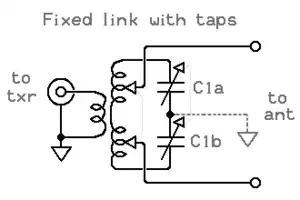
Fixed link with taps
The Fixed link with taps is the most basic circuit. The factor will be nearly constant and is set by the number of relative turns on the input link. The match is found by tuning the capacitor and selecting taps on the main coil, which may be done with a switch accessing various taps or by physically moving clips from turn to turn. If the turns on the main coil are changed to move to a higher or lower frequency, the link turns should also change. The standard positioning of the attachment points for the coil taps is symmetrical. Both tap points are equally spaced from the center of the coil, and when the connections are moved, they are moved the same distance in opposite directions: Either both tapped points are moved away from the center of the coil, or both tapped points are moved towards the center of the coil by the same distance.
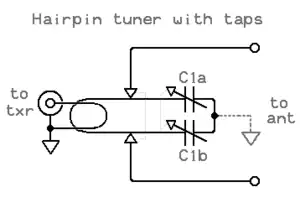
Hairpin tuner
The Hairpin tuner (right) is effectively the same electrical circuit as the fixed link with taps, above, but uses "hairpin" inductors (a tapped transmission line, short-circuited at the far end) instead of coiled inductors.[3](p 24‑12) Moving the tap points along the hairpin allows continuous adjustment of the impedance transformation, which is difficult on a solenoid coil.
It is useful for very short wavelengths from about 10 meters to 70 cm (frequencies about 30 MHz to 430 MHz) where a coiled inductor would have too few turns to allow fine adjustment. These tuners typically operate over at most a 2:1 frequency range.

Swinging link with taps
Swinging link with taps modifies the Fixed link with taps by mounting the primary winding on a movable ("swinging") platform that can be brought closer to, or further from, the transformer. The swinging link is a form of variable transformer, that changes the coils' mutual inductance by swinging the primary coil in and out of the gap between halves of the secondary coil.
Meshing the primary winding more completely inside the secondary winding also allows fine adjustment with fewer coil taps (an effectively similar and less complicated circuit modification, mentioned below, is to put a capacitor in series with the primary). The variable inductance makes these tuners more flexible than the basic circuit, but at some cost in complexity, both in terms of construction and in terms of dealing with more possible adjustments. Conventionally, the connected tap points on the coil are positioned symmetrically around the coil's center.
Double-tuned transformer
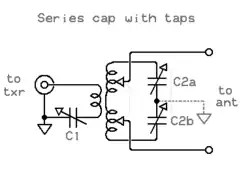 Schematic for a fixed-link double-tuned transformer, with a tapped secondary, and series input and parallel output capacitors.[lower-alpha 23][lower-alpha 24]
Schematic for a fixed-link double-tuned transformer, with a tapped secondary, and series input and parallel output capacitors.[lower-alpha 23][lower-alpha 24]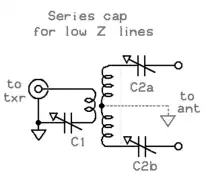 Schematic for a fixed-link double-tuned transformer, with both output capacitors in series – suitable for low impedance output.[lower-alpha 23]
Schematic for a fixed-link double-tuned transformer, with both output capacitors in series – suitable for low impedance output.[lower-alpha 23]
The diagrams, right, show two alternate configurations of nearly the same circuit: Series cap with taps (left) attaches the antenna in parallel with the transformer coil and capacitor C2, via taps, and Series cap for low-Z lines (right) attaches the antenna in series with the coil and capacitor C2.
Using C1 to tune or de-tune the primary winding to the tuning of the secondary winding by C2 has approximately the same effect as moving the two windings closer or further apart, similar to the swinging link (described in the prior subsection).
- Series cap with taps
- (left) adds a series capacitor to the input side of the Fixed link with taps. The input capacitor allows fine adjustment with fewer taps on the main coil. As described above, the connected tap points on the coil are positioned symmetrically around the coil's center.
- Series cap for low-Z lines
- (right) shows an alternate connection for the series capacitor circuit that dispenses with taps on the coil, but is only useful for feedlines showing low impedance at their ends. The capacitors marked C2a and C2b must be electrically disconnected and isolated from ground, as well as being "ganged" through an insulated connection.
Fixed link with differential capacitors
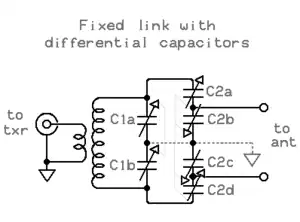
The Fixed link with differential capacitors circuit (right) was the design used for the well-regarded Johnson Matchbox (JMB) tuners.
The four output capacitor-sections (C2a,b,c,d) are a "ganged" double-differential capacitor: The rotor axels of the four sections are mechanically connected and their plates aligned, so that as the top and bottom capacitor sections (C2a & C2d) increase in capacitance the two middle sections (C2b & C2c) decrease in capacitance, and vice versa (notice the arrow heads on C2 in the diagram are shown with both matching and contrary directions). This provides a smooth change of loading that is electrically equivalent to moving taps on the secondary. The Johnson Matchbox used a band switch (not shown) to change the number of turns on the transformer secondary for each of the five frequency bands available to hams in the 1940s.[28]
The JMB design has been criticized since the two middle-section capacitors C2b & C2c are not strictly necessary to obtain a match;[29][30] however, the middle sections conveniently limit the disturbance of the adjustment for C1 caused by changes to C2.
Double-tuned link with differential capacitors

Later designs enhancing the limited range of the otherwise respected Johnson Matchbox (JMB) to accommodate the many more modern shortwave amateur bands, either add switched taps to the link (input) inductor, or may include a capacitor in series with the input coil winding.[28][30][31][32] Both of these extra adjustments are shown in the schematic (right). As in the case of the double-tuned transformer and the swinging link matching networks described above, these are both ways to allow fine-tuning without meddling with the JMB bandswitch (not shown) and its intricately soldered connections to the secondary coil which changes the number of turns used on the output side.
Using C1 to tune or de-tune the primary side of the transformer to the settings for C2 + C3 on the secondary side has approximately the same effect as moving the two sides of the transformer closer or further apart, hence simulating a swinging link. Adjusting the number of taps on the primary coil adjusts the Q of the network, widening or narrowing its matched frequency span, and permits compensation for change in Q resulting from the bandswitch changing the number of connected secondary turns; it also gives purpose to the generally unused extra primary windings that were originally part of a separate relay-switched feed for older 600 Ω receivers, which were still in use during the 1940s.
Including the band switch (not shown), this circuit has five separate available controls, which complicates adjusting its settings.
Z match
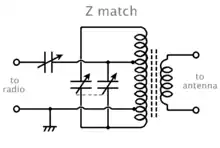
The approach taken with the Z-match design is to incorporate a conventional two-winding transformer into the transmatch in order to have the option to deliver balanced output from the matching circuit. The separate input and output windings isolate the ground on the input side from the output side (grounded or ungrounded), which permits the connection of either balanced or unbalanced loads on the output side, regardless of the input side connection, ensures that the output currents are balanced, and allows the output voltages to float with respect to ground.
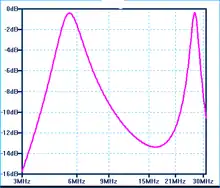
The Z-match is an ATU widely used for low-power amateur radio which is commonly used both as an unbalanced and as a balanced tuner.[33][34] The Z match is a doubled version of a resonant transformer circuit, with three tuning capacitors.[lower-alpha 25]
Two of the capacitors with separate connections to the primary transformer coil are ganged, and effectively constitute two separate resonant transformer circuits, which simultaneously tune two distinct resonant frequencies. The double-resonance enables the single circuit across the coil to cover a wider frequency range without needing to switch the inductance: Every setting offers two different frequencies, in separate frequency bands, that are both impedance matched at once. Because the output side is a transformer secondary (optionally grounded) it can be used to feed either balanced or unbalanced transmission lines without any modification to the circuit.
The Z-match design is limited in its power output by the core used for the output transformer. A powdered iron or ferrite core about 1.6 inches in diameter should handle 100 W. A tuner built for low-power use ("QRP" – typically 5 W or less) can use a smaller core.[34]
Balanced match from an unbalanced tuner and a balun
Another approach to feeding balanced lines is to use an unbalanced tuner with a balun on either the input (transmitter) or output (antenna) side of the tuner. Most often using the popular high pass T circuit described above, with either a 1:1 current balun on the input side of the unbalanced tuner or a balun (typically 4:1) on the output side. It can be managed, but doing so both efficiently and safely is not easy.
Balun between the antenna and the ATU
Any balun placed on the output (antenna) side of a tuner must be built to withstand high voltage and current stresses, because of the wide range of impedances it must handle.[35]
For a wide range of frequencies and impedances it may not be possible to build a robust balun that is adequately efficient. For a narrow range of frequencies, using transmission line stubs or sections for impedance transforms (as described above) may well be more feasible and will certainly be more efficient.
Balun between the transmitter and the ATU
The demands put on the balun are more modest if the balun is put on the input end of the tuner – between the tuner and the transmitter. Placed on that end it always operates into a constant 50 Ω impedance from the transmitter on one side, and has the matching network to protect it from wild swings in the feedline impedance on the other side: All to the good. Unfortunately, making the input from the transmitter balanced creates "hot ground" problems that must be remedied.
If an unbalanced tuner is fed with a balanced line from a balun instead of directly from the transmitter, then its normal antenna connection – the center wire of its output coaxial cable – provides the signal as usual to one side of the antenna. However the ground side of that same output connection now becomes the feed of an equal and opposite current to the other side of the antenna; the only unsatisfactory consequence is that the entire grounded portion of the tuner becomes "hot" with RF power, including the tuner's metal chassis, metal control knobs, and insulated knobs' metal set-screws, all touched by the operator.
The "hot ground" inside the ATU
The "true" external ground voltage at the antenna and transmitter must lie halfway between the two "hot" feeds, one of which is the internal ground: Inside the ATU, the matching circuit's "false" ground level is equally different from the "true" ground level at either the antenna or the transmitter as the original "hot" wire is, but with opposite polarity. Either the usual "hot" output wire or the matching circuit "hot ground" will give you exactly the same shock if you touch it.
The tuner circuit must "float" above or below the exterior ground level in order for the ATU circuit ground (or common side) that formerly was attached to the output cable's ground wire to feed the second hot wire: The circuit's floating ground must provide a voltage difference adequate to drive current through an output terminal to make the second output "hot".[3](p 24‑13)
High voltages are normal in any efficient ("high Q") impedance matching circuit bridging a wide mismatch. Unless the incompatible grounds are carefully kept separate, the high voltages present between this interior floating ground (the "false" ground) and the exterior transmitter and antenna "true" grounds can lead to arcing, corona discharge, capacitively coupled ground currents, and electric shock.[lower-alpha 26]
Carefully keeping the incompatible grounds separate
To reduce power loss and protect the operator and the equipment, the tuner chassis must be double-layered: An outer chassis and an inner chassis. The outer chassis must enclose and separate the tuning circuit and its floating ground from the outside, while itself remaining at the level of the exterior "true" ground(s). Inside the protective outer chassis, the inner chassis can maintain its own incompatible floating ground level, safely isolated.
The inner chassis can be reduced to nothing more than a mounting platform inside the outer chassis, elevated on insulators to keep a safe distance between the "floating ground" and the outer chassis wired to the "true" electrical ground line(s). The inner tuning circuit's metal mounting chassis, and in particular the metal rods connected to adjustment knobs on the outer chassis must all be kept separate from the surface touched by the operator and from direct electrical contact with the transmitter's ground on its connection cable ("true" ground).
Isolating the controls is usually done by replacing at least part of the metal connecting rods between knobs on the outside surface and adjustable parts on the inside platform with an insulated rod, either made of a sturdy ceramic or a plastic that tolerates high temperatures. Further, the metal inner and outer parts must be spaced adequately far apart to prevent current leaking out via capacitive coupling when the interior voltages are high. Finally, all these arrangements must be secured with greater than usual care, to ensure that jostling, pressure, or heat expansion cannot create a contact between the inner and outer grounds.
Summary
Using an inherently unbalanced circuit for a balanced tuner puts difficult constraints on the tuner's construction and high demands on the builder's craftsmanship. The advantage of such a design is that its inner, inherently unbalanced matching circuit always requires only a single component where a balanced version of the same circuit often requires two. Hence it does not require identical pairs of components for the two "hot" ends of the circuit(s) in order to ensure balance to ground within the ATU, and its output current is inherently balanced, even though its interior circuit is unbalanced with respect to the interior "false" ground.
Antenna system losses
Efficiency and SWR
If there is still a high standing wave ratio (SWR) beyond the ATU, in a significantly long segment of feedline, any loss in that part of the feedline is typically increased by the transmitted waves reflecting back and forth between the impedance change at the tuner output and the impedance change at the antenna feedpoint, compounding the normal resistive losses in the transmission line by making multiple passes through it. Even with a matching unit at both ends of the feedline – the near ATU matching the transmitter to the feedline and the remote ATU matching the feedline to the antenna – loss in the circuitry of the two ATUs will still slightly reduce power delivered to the antenna.
- The most efficient use of a transmitter's power is to use a resonant antenna, cabled via a feedline whose impedance is the same as the antenna's feedpoint, fed by a transmitter which has that same feed impedance. There are still small losses in every realistic feedline, even when all impedances match, but matching minimizes that loss.
- It is almost equally efficient to feed a remote antenna tuner attached directly to the antenna, via a feedline matched to both the transmitter and the ATU feed. The only extra losses are in the tuner circuitry, which can be kept small if the tuner is adjusted for a "good" match (see below) and the degree of mismatch carefully tested at or near the antenna (not at the transmitter).
- It is usually inefficient to operate an antenna far from one of its resonant frequencies and attempt to compensate with an ATU next to the transmitter, far from the antenna; the entire feedline from the ATU to the antenna is still mismatched, which will aggravate normal loss in the feedline, particularly if it is low-impedance line, like standard 50 Ω coax.
- The least efficient way to transmit is to feed a non-resonant antenna through a mis-matched, lossy feedline, with no impedance matching anywhere.
ATU placement
An ATU can be inserted anywhere along the line connecting the radio transmitter or receiver to the antenna.[36] The antenna feedpoint is usually high in the air or far away,[lower-alpha 27] and a long transmission line (feedline) must carry the signal across the long distance between the transmitter and the antenna. The tuner can be placed anywhere along the feedline – at the transmitter output, at the antenna input, or anywhere in between – and if desired, two or more matching networks can be placed at different locations between the antenna and the transmitter (usually at the two ends of the feedline) and adjusted so that they co‑operatively create an impedance match throughout the antenna system.
Antenna matching is best done as close to the antenna feedpoint connection as possible, to increase bandwidth, and to minimize loss in the transmission line by reducing its voltage and current peaks. Ideally, a tuning circuit made from nearly quarter-wave stubs might be incorporated into the body of the antenna itself, producing at least an approximate match at the antenna feed. Also, when the information being transmitted has frequency components whose wavelength is a significant fraction of the electrical length of the feedline, distortion of the transmitted information will occur if there are standing waves on the line. Analog TV and FM stereo broadcasts are affected in this way; for those modes, matching at or very near the antenna is mandatory.
When possible, an automatic or remotely-controlled tuner in a weather-proof case at or near the antenna is convenient and makes for an efficient system. With such a tuner, it is possible to match a wide variety of antennas over a broad range of frequencies[37] (including concealed antennas).[38][39]
High-impedance feedline

(A) Outer plastic jacket, (B) Woven copper shield, (C) Inner dielectric insulator, (D) Copper core
When the ATU must be located near the radio for convenient adjustment, any significant SWR will increase the loss in the feedline, unless the antenna feedpoint itself is positioned at the radio and directly connects to the back of the tuner. For that reason, when using a remote antenna with an ATU sitting at the transmitter, low-loss, high-impedance feedline is a great advantage (open-wire line, for example).
Through to the 1950s balanced transmission lines of at least 300 Ω were more-or-less standard for all shortwave transmitters and antennas, including amateurs' equipment. Most shortwave broadcasters continue to use high-impedance feedlines,[6](Ch. 7.2 )[lower-alpha 2] even after automatic impedance matching has become commonly available.
High impedance lines – such as most parallel-wire lines – carry power mostly as high voltage rather than high current, and current alone determines the power lost to line resistance. So for the same number of Watts delivered to the antenna, typically very little power is lost in high-impedance line even at severe SWR levels, when compared to losses for the same SWR in low-impedance line, like typical coaxial cable. For that reason, radio operators using high-impedance feedline can be more casual about where along the line they bother to match up the impedances.
A short length of coaxial line with low loss is acceptable, but with longer coaxial lines the greater losses, aggravated by SWR, become very high.[12](p 7‑4) It is important to remember that when an ATU is placed near the transmitter and far from the antenna, even though the ATU matches the transmitter to the line there is no change in the line beyond the ATU. The backlash currents reflected from the antenna are retro-reflected by the ATU and so are invisible on the transmitter-side of the ATU. Individual wave fronts are usually reflected between the antenna and the ATU several times; the result of the multiple reflections is compounded loss, higher voltage and / or higher currents on the line and in the ATU, and narrowed bandwidth. None of these bad effects can be remediated by an ATU sitting beside the transmitter.
Loss in antenna tuners
Every means of impedance match will introduce some power loss. This will vary from a few percent for a transformer with a ferrite core, to 50% or more for a complicated ATU that has been naïvely adjusted to a "bad" match, or is working near the limits of its tuning range.[11][12](p 4‑3)
Among the narrow-band tuner circuits, the ‘L’ network has the lowest loss,[20] partly because it has the fewest components, but mainly because it can match at just one setting, and that setting is necessarily the lowest Q possible for a given impedance transformation.[lower-alpha 28] In effect, any ‘L’ network gives its operator no option to choose a "bad" match: The only ‘L’ network settings that produce a match are as good as it gets with the selected network.
The ‘L’ network using only capacitors will have the lowest loss, but this network only works where the load impedance is very inductive, making it a good choice for a small loop antenna. Inductive impedance also occurs with straight-wire antennas used at frequencies above their first resonance and below the second, where the antenna is too long – for example, a monopole longer than a quarter wave and shorter than half wave long at the operating frequency. One can deliberately configure the size of an antenna so that it will be inductive on all its design frequencies (similar to a small loop) with the intention of using only capacitors to tune it, so as to have minimal tuning losses without concern for settings. Doing so requires making a straight-wire antenna a bit too long for its lowest operating frequency, but unfortunately the typical problem encountered in the lower HF bands is that antennas are too short for the frequency in use; their matching circuits require inductance.
With the high-pass ‘T’ network, the loss in the tuner can vary from a few percent – if tuned for lowest loss – to over 50% if the tuner is adjusted to a "bad match" instead of a good one.[11][4]
Optimum match finding rules
There are several simple rules of thumb for finding the optimum matchpoint and avoiding the "bad" matchpoint. They are mainly intended for tuning using only an SWR meter and minimizing standing wave ratio, which gives no direct indication of how "good" or "bad" the found match may be. All are based on the fact that a three-element network can simulate an ‘L’ network, and the match achieved by an ‘L’ network is the lowest-loss for that network configuration[20] (high-pass and low-pass ‘L’ networks might have different losses for matching the same antenna). However, note that losses in long cabling and the antenna's ground system often overwhelm even "bad match" tuner losses, in which case transmatch loss becomes irrelevant.
Maximum capacitance rule (high-pass ‘T’):
As a rule of thumb only for a common high-pass ‘T’ match, using the maximum possible capacitance (and minimum possible inductance) for every tuner setting will involve the least loss, as compared to simply tuning for any match, without regard for the settings.[11][4] In general, this is because increasing the capacitance produces less reactance. The usual consequence of high capacitance (low reactance) is that less counter-balancing reactance is needed from the inductor[11] which means running current through fewer turns of wire on the inductor coil, and the loss in almost every ATU is mainly from resistance in the inductor wire (loss from dirty capacitor contacts comes in a distant second).[4]
In the high-pass ‘T’ circuit, setting either the left or right capacitor to its maximum causes it to have almost no reactance, and it almost vanishes from the circuit, leaving the remaining capacitor and inductor to approximate an ‘L’ network. The only impedance match possible for the (almost) ‘L’ network consisting of the two remaining components will be (approximately) optimal – that is, will have the lowest current possible through the inductor, hence lowest loss inside the network.
Minimum inductance rule (low-pass ‘T’):
Similar reasoning applies to a low-pass ‘T’ match: Setting the left or right inductor to its minimum value will make it (almost) vanish from the circuit and leave the remaining inductor and the capacitor to form an ‘L’ match, whose only match setting is minimum loss.
Minimum capacitance rule (low-pass ‘π’):
For a ‘π’ match a different rule applies – a seemingly contrary minimum capacitance rule – but the reasoning for it is the same: Consult the rules for choosing step-up and step-down networks, then accordingly set either the left or right capacitor to its minimum value, the other capacitor to its maximum value, and the inductor set very low. The minimized capacitor will have its maximum possible reactance, and that high reactance will obstruct the flow of current through it, and the bottomed-out capacitor will (almost) drop out of the matching network (almost become a broken circuit ≈ no connection). The remaining capacitor and the central inductor form (almost) an ‘L’ match, whose only match is optimal (lowest inductance / lowest loss). Since the search begins with the matching capacitor set at maximum (minimum reactance) and so is gradually reduced, the first matching inductance encountered will tend to be the lowest.
Caveat operator:
The radio operator needs to keep a sensible perspective on the limits to whether optimizing a matching network is worthwhile: Matching losses are typically low, and if losses in the feedline beyond the feedline coupler are high, achieving lowest losses in the transmatch will be irrelevant – ‘only one drip in a bucket’. Cable losses beyond any kind of matching network always remain unimproved, regardless of whether the match settings are good or bad. The only cure for lossy cable is to place the tuner immediately next to the antenna feedpoint, and run any long segments of cabling between the tuner and the transmitter:
- transmitter → cable → tuner → antenna.
In those cases where a tuner is actually needed, the more common
- transmitter → tuner → cable → antenna
configuration will have high losses which cannot be reduced by the tuner: High cable loss makes striving for tuner efficiency a mostly futile exercise.
Recognizing "bad" matches
Every matching network with three reactive components, given fixed settings for the first two components, almost always has two distinct settings (or no settings at all!) for the third component that both achieve a match.[lower-alpha 29] Typically, one setting results in higher loss than the other, and sometimes the difference is large enough to be important; usually, but not necessarily, the setting that needs the highest inductance is the "bad" match (highest loss), and that is what the "maximum capacitance rule", above, seeks to avoid. However, it is sometimes possible for a lower-inductance setting to create an internal-only resonance that winds up circulating more current through the resonating coil. The resonant circulation through the coil might be enough more to cause higher loss at the lower inductance. In that case, the above rule of thumb does not give good guidance.
- Infallible guide
The infallible guide is to "try it and see, measure it, and record it". For any one combination of antenna and transmatch, once a table of both optimum settings and their "evil twin" infimum (worst) matched settings have been found by scanning the possible settings, the table can used as a guide for quickly finding a good setting inbetween frequencies with known-good match settings: The optimum settings for the new frequency will lie between the settings for the two optimal matches previously found at an adjacent higher and adjacent lower frequency in the same band, with very rare exceptions where the settings "jump".[lower-alpha 30] Likewise the worst possible matched settings will lie between the corresponding infimal settings for the bracketing frequencies, which indicate a "zone of avoidance" – settings to not use. Hence matching unit operators can recognize that they've accidentally found a "bad" match instead of "good" match, when its settings fall inbetween the infimal settings for the higher and lower bracketing frequencies.
A table of previous optimal settings can be used as close starting points for a search at a bracketed new frequency. Where the entries are spaced close enough in frequency, the table will give a start that's near enough that the new optimum setting can be reached merely by seeking the lowest reading on an SWR meter, even though the SWR meter cannot show only losses in the matching network.
- Loss measurement
For the "measure it" part that creates or extends a table of optimum settings in the first place, an SWR meter will not work, since it does not directly show loss, and can not indicate just the losses in the transmatch. However, with a few hookup changes, the matching network's losses can easily be found with an antenna analyzer or impedance bridge.[40]
A low-tech approach to gauge ATU losses is to power-off the transmitter, soon after transmitting, and place one's hand directly on the coil (after first discharging the coil to the matchbox chassis). If it feels too hot to touch or too warm to comfortably hold, then the coil losses are high and the setting is "bad"; if the coil feels cool or just mildly warm then there is no significant loss, either because of a "good" match or because the earlier transmit power was too low to noticeably heat the coil.[lower-alpha 26]
- Typical problems
One of the causes[11][12] for high loss in tuning circuits arises when the settings produce a path for an internal resonance among the components that lies entirely inside the matching network itself, without circulating through the antenna: Multiple internal passes through the tuning coil will compound its normal losses, just like multiple passes through a mismatched feedline can. When the configured path does not route most of the current through the antenna, then that fraction of the current only flowing in the coil and not the antenna will only deliver power as heat, not radio waves. Situations like this are possible when a near-resonant capacitor-inductor combination is used to raise voltage for a much higher impedance output.
At some point near the extreme possible settings for any one of the installed components, the possible match settings for the system will be curtailed, and the best match may be the first to drop out (require an impossibly high or low setting[lower-alpha 17]). If the configuration of component settings with the least loss is not feasible with the installed components, and the loss for the achievable setting is appreciably worse, then despite still being able to find a match for the impedance, the only match the ATU is able to provide is "bad". A simple clue that the matching network has reached or is near the point where its settings are dropping out, is when an available configuration has one of the setting knobs "pegged out", or nearly so, and adjusting away from the pegged or extreme setting only makes the match worse – that is, any alternative to the pegged match or near-match cannot be improved by a slight adjustment of the other components' settings.
Sacrificing efficiency in exchange for harmonic suppression
If additional filtering is desired, the inductor in any of the three-element designs can be deliberately set to slightly larger values than the minimum necessary, raising the circuit Q and so provide at least a partial band-pass effect in the high-pass and low-pass networks.
Ordinary harmonics are always above the operating frequency, and all low-pass matching networks block higher frequencies at any matched setting, including the lowest-loss setting; low-pass ‘π’, low-pass ‘T’, and low-pass ‘L’ networks always attenuate harmonics well.
High-pass ‘L’ and optimally adjusted high-pass ‘T’ networks will not block harmonics, however the high-pass ‘T’ can be adjusted to have a slight band-pass effect if its inductance is set above its minimum: The additional attenuation at harmonic frequencies can be increased significantly with only a small percentage of additional loss at the tuned frequency.[41][11] The ‘T’ match's obtainable rejection factor of 99% (20 dB)[41] may be enough harmonic reduction, if the small additional loss is acceptable.
Although they always block harmonics, the low-pass ‘π’ and low-pass ‘T’ networks can also be adjusted for excess inductance / higher Q similar to the high-pass ‘T’ to achieve a partial bandpass, perhaps to reduce interference coming from below the operating frequency.
The SPC tuner is a band-pass circuit, so it always blocks out-of-band signals, both above and below, but it can be made to have an especially narrow pass-band when adjusted for similarly higher-than-necessary inductance, perhaps to "quiet" nearby interference on a noisy band. At any match setting, an SPC tuner will always have much better harmonic rejection than a high-pass ‘T’, even one that is tuned for higher Q / modest high-frequency reduction.[41]
Standing wave ratio
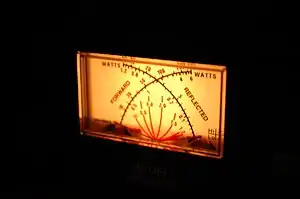
It is a common misconception that a high standing wave ratio (SWR) per se causes loss, or that an antenna must be resonant in order to transmit well; neither is true.[9][10][2]
A well-adjusted ATU feeding an antenna through a low-loss line may have only a small percentage of additional loss compared with an intrinsically matched antenna, even with a high SWR (4:1, for example).[2] An ATU sitting beside the transmitter just re-reflects energy reflected from the antenna ("backlash current") back yet again to the antenna ("retro-reflection") along the low-loss feedline; the portion of the reflected and retro-reflected waves that survive the losses do eventually radiate out.[9]
High losses are caused by resistance in the feedline, and the close by soil below the antenna, and the metal in the antenna – especially where the current flows through corroded parts. Multiple reflections due to high SWR cause all these losses to be compounded. However, the total of the losses for multiple passes greatly depends on the size of the single-pass loss resistance, relative to the antenna's radiation resistance. Using a good ground system and low-loss, high-impedance feedline results in very little loss, even with multiple reflections, because even a low radiation resistance in the antenna can out-compete line and ground resistances, if those are very low. However, if the combined feedline and ground-system is "lossy", like coaxial line,[lower-alpha 2] or a mere ground rod, then an identical high SWR may waste a considerable fraction of the transmitter's power output heating up the coax and warming the soil. In comparison, parallel-wire, high impedance line typically has extremely low loss, even when SWR is high. For that reason, radio operators using high-impedance line with an extensive ground system can be more relaxed about use of matching units and where they are placed on the feedline.
Without an ATU, the SWR from a mismatched antenna and feedline can present an improper load to the transmitter, causing distortion and loss of power or efficiency with heating and / or burning components in the output stage. Modern solid state transmitters are designed to automatically protect themselves by reducing power when confronted with backlash current. Consequently, all modern solid-state power stages are designed to only produce faint signals when the SWR rises above some cutoff level, often set at 1.5 : 1 .[lower-alpha 3] This output stage power cutback is the main reason for weak transmission at high SWR, not the lesser losses to increased heating of the antenna system parts.
Were it not for the problem created by the design conflict between circuit safety and delivered transmit power, even the marginal losses from an SWR of 2:1 might otherwise be tolerated, since only 11 percent of transmitted power would be reflected and 89 percent sent through to the antenna (a loss of only 1/ 2 dB). So the main loss of power at high SWR is due to the output amplifier "backing off" its power when struck by backlash current.
Vacuum tube-based transmitters and amplifiers usually have an adjustable output network (a ‘π’ network) that can feed mismatched loads up to perhaps 3:1 SWR without trouble. For all practical purposes, the ‘π’ network in the output stage is a built-in transmatch. Further, despite being mechanically fragile, tubes are electrically robust, and as long as the line voltage stays moderate they can shrug off very high backlash current with impunity. So tube-based output stage amplifiers benefit from "backing off" their output power only in response to very high backlash voltage, and their self-protection circuitry (if any) can be safely configured to tolerate much worse SWR than solid-state amplifiers.
Broadcast applications
AM broadcast transmitters

One of the oldest applications for antenna tuners is in mediumwave and shortwave AM broadcast transmitters. Typical AM band transmitters use vertical tower antennas, usually between 1 /5 and 5 /8 wavelengths tall. An ATU housed in the "coupling hut" at the base of the tower[42] is used to match the antenna to the transmission line from the transmitter. The most commonly used circuit is a low-pass ‘T’ network.[5]
When multiple towers are used, the matching network may also need to provide for a phase adjustment, to advance or delay the current to each tower, relative to the others; done properly, phasing can aim the combined signal in a desired direction.[lower-alpha 31]
High-power shortwave transmitters
High-power (50 kW and above) international shortwave broadcast stations change frequencies seasonally – even daily – to adapt to ionospheric propagation conditions, so their signals can best reach their intended audience.[43] Frequent transmitting frequency changes require frequent adjustment of antenna matching, but modern broadcast transmitters typically include built-in automatic impedance-matching circuitry that can accommodate modest impedance changes. Similar circuitry is also becoming increasingly common in amateur transmitters.
Modern internal ATU circuits typically can self-adjust to a new frequency or new output impedance within 15 seconds, for SWR up to 2:1 (at least).[6](Ch. 7.2 ) The matching networks in transmitters sometimes incorporate a balun or an external one can be installed at the transmitter in order to feed a balanced line.
The most commonly used shortwave antennas for international broadcasting are the HRS antenna (curtain array), which covers a 2:1 frequency range, and the log-periodic antenna, which can cover up to an 8:1 frequency range.[44] Within the design range, the antenna SWR will vary, but these designs usually keep the SWR below 1.7 : 1 , which is easily within the range of SWR that can be tuned by built-in automatic antenna matching in many modern transmitters. So when feeding well-chosen antennas, a modern transmitter will be able to adjust itself as needed to match to the antenna at any frequency.
Automatic tuners
Automatic antenna tuning is used in flagship mobile phones, transceivers for amateur radio, and in land mobile, marine, and tactical HF radio transceivers.
Each antenna tuning system (AT) shown in the figure has an “antenna port”, which is directly or indirectly coupled to an antenna, and another port, referred to as “radio port” (or as “user port”), for transmitting and / or receiving radio signals through the AT and the antenna. Each AT shown in the figure has a single antenna-port, (SAP) AT, but a multiple antenna-port (MAP) AT may be needed for MIMO radio transmission.

Several control schemes can be used in a radio transceiver or transmitter to automatically adjust an antenna tuner (AT). The control schemes are based on one of the two configurations, (a) and (b), shown in the diagram. For both configurations, the transmitter comprises:
- antenna
- antenna tuner / matching network (AT)
- sensing unit (SU)
- control unit (CU)
- transmitter and signal processing unit (TSPU)
The TSPU incorporates all the parts of the transmitting not otherwise shown in the diagram.
The TX port of the TSPU delivers a test signal. The SU delivers, to the TSPU, one or more output signals indicating the response to the test signal, one or more electrical variables (such as voltage, current, incident or forward voltage, etc.). The response sensed at the radio port in the case of configuration (a) or at the antenna port in the case of configuration (b). Note that neither configuration (a) nor (b) is ideal, since the line between the antenna and the AT attenuates SWR; response to a test signal is most accurately tested at or near the antenna feedpoint.
Control scheme types[45] Control
schemeConfigur-
ationExtremum
seeking?Type 0 [n/a] [n/a] Type 1 (a) No Type 2 (a) Yes Type 3 (b) No Type 4 (b) Yes
Broydé & Clavelier (2020) distinguish five types of antenna tuner control schemes, as follows:[45]
- Type 0 designates the open-loop AT control schemes that do not use any SU, the adjustment being typically only based on previous knowledge programmed for each operating frequency
- Type 1 and type 2 control schemes use configuration (a)
- type 2 uses extremum-seeking control
- type 1 does not seek an extreme
- Type 3 and type 4 control schemes use configuration (b)
- type 4 uses extremum-seeking control
- type 3 does not seek an extreme
The control schemes may be compared as regards:
- use of closed-loop or open-loop control (or both)
- measurements used
- ability to mitigate the effects of the electromagnetic characteristics of the surroundings
- aim / goal
- accuracy and speed
- dependence on use of a particular model of AT or CU
See also
Footnotes
- Although the various terms listed above are typically used interchangeably, the terms matching network and transmatch are clearly the most accurate description of purpose and function. Some of the names, like "antenna tuner" are misleading even though conventional. Textbooks always carefully point out that the "antenna tuner" does not actually tune the antenna, and the use of that name is contested by some.
-
Since the early 1960s, perhaps earlier, almost all available coaxial cable suitable for transmition power-levels is either 48~52 Ω or 70~75 Ω impedance, (Television cabling adopted 75 Ω cable, which is sometimes used by radio amateurs.) Since then, radios have been designed to be compatible with the available 50 Ω cable, and at present it is essentially universal / used world-wide.
The only benefit of designing equipment with 50 Ω connection impedances is standardization for radios, feedlines, and antennas; it is merely convenient – not ideal – and like many standards, is only used for historical reasons.
-
The output-stage amplifier is always the component that bears the brunt of any damage. That is the part of the radio where self-protection circuits are installed (if any) to drop the output power to safe levels when confronted with a threatening mismatch.
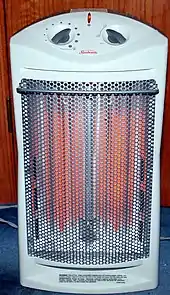 A quartz space heater that draws wattage roughly similar to a high-power amplifier
A quartz space heater that draws wattage roughly similar to a high-power amplifier - Transmitters with built-in antennas that only cover a single, narrow frequency band, such as cell phones and walkie-talkies, have an internal, non-user adjustable ATU circuit, permanently set to match the radio to its installed antenna.
-
Both antennas and open wire feedlines change impedance with the weather – especially if either is coated with dust, rust, water from ice or rain, salt from sea spume, or sits in humid air. Changing the transmit frequency also changes an antenna's feedpoint impedance, with changes at some frequencies causing wider or more abrupt impedance change than at others.
-
All technical sources include eliminating the feedpoint reactance as the essential part of "tuning" an antenna, but different books might or might not mention raising or lowering the resistance of its feedpoint in the same part of the text as "antenna tuning"; however, in that case, adjusting feedpoint resistance is always mentioned elsewhere.[2][3][4][5][6][7]
- The upper HF and higher frequencies are naturally noise-free, but the quiet can be spoiled by nearby noise sources; for example: lightning storms a few tens of miles away, or badly-made rechargers for hand-carried electronics in one's own and neighboring houses.
- Typical impedance transform ratios are 1:1, 1:4, 1:9, etc. The impedance ratio is the square of the winding ratio.
- When two differently-grounded cables or circuits must be connected but the grounds kept independent, a full, two-winding transformer with the desired ratio must be used, instead of a single-winding autotransformer.
- The same windings could be connected differently to make a balun instead.
- When working with coax the stub section is attached using a ‘T’-connector.
-
For lengths between a quarter and a half wave, the reactive behavior of a stub-line is opposite.[15]
- Note that Smith chart vertical scales are all intersections of asymmetric arcs, with highly distorted, non-linear measure.
- This chart was made with 50 Ohms at the center. For matching to other values of source R such as 75 Ohms, the value "75" should replace "50" everywhere in the Smith chart.
- Although the shapes ┬─ and ─┬ do resemble stair-steps, the sense of the step "going up" and "going down" is opposite the direction of the impedance transform; so using the step shape is probably more prone to cause confusion than to be helpful.
-
When no information is available about the reactive and resistive parts of the impedance to be matched, a network can be chosen by arbitrarilly guessing that a high impedance might be matched using network 1 (which is effective for high shunt or parallel resistance) and a low impedance using network 2 (which is effective for low series resistance), but those selections assume that the cause of the impedance mismatch that causes a high SWR is mainly due to resistance being too high or too low, rather than too much reactance (either positive or negative).
-
Many matching networks can match any impedance in principle, but note that any one transmatch as-built can only match impedances for which the ranges of inductance and capacitance of its installed parts are adequate.[20] - For example, multi-kilowatt AM stations often overload shortwave receivers within a few of miles of their tower, despite operating on a much lower frequency. In that case, attenuation of low frequencies would be an added benefit, and a high-pass network would be preferred for its side-effect of blocking medium frequencies if set to match on a shortwave frequency.
- The choice of a series-inductor / shunt capacitor ‘L’ network makes automatic tuners usable in combination with other electrical parts on the antenna, such as relay switches, that require a piggyback DC power feed through the RF feedline. It also conforms to the old-fashioned expectation that transmatches will attenuate harmonics.
- Many recent small loop designs instead feed the main loop indirectly, connected through a feeder loop, about 1 /5 the main loop's size, nested inside the otherwise unconnected larger loop. The two magnetically coupled loops act as a 25:1 impedance transformer. If the main loop has been resonated by a tuning capacitor, making it reactance-free, the two-loop combination may provide an adequately matched impedance, without needing an ‘L’ network.
- In the electrical conjugate of a circuit all of the parallel reactive elements (capacitors and inductors) are replaced by series elements of the opposite type (e.g. capacitors wired in parallel are replaced by inductors in series), and similarly, series reactive parts are replaced by parallel components of the opposite type. Resistors (if any) are left unchanged, and incidental loss resistances in reactive components are ignored.
-
There is usually no benefit to forcing the two sides of an antenna to balance voltages. It is almost always better to allow the antenna to "float" with respect to an earth ground,[25] since antenna performance that depends on balance always depends on balanced current rather than balanced voltage. Forcing voltages to balance may actually unbalance currents, and hence cause poor performance.
-
Regarding optional and mandatory ground connections:
-
Removing the optional ground on the balanced (right) side of the circuit does require the dual-section variable capacitor to be mounted so that it can electrically "float", with its frame and tuning shaft insulated from the chassis and tuning knob. When such insulated mounting is provided, there is no reason to use a dual-section capacitor and it can be replaced by a less expensive single-section capacitor. - Note that the metal frames (if any) of each of the capacitors in the design must be electrically isolated from ground.
-
Although "sparking" is a bad sign, it is not related to transmitting high power through a bad match. Perversely, the higher voltages that occur with the higher Q typical of a good match are more likely to have sparking, whereas a "bad" match would have low Q that would tend to suppress sparks.
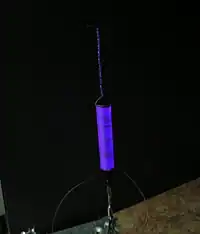 Corona discharge around an antenna coil
Corona discharge around an antenna coil -
One "high in the air" antenna example would be a horizontal dipole antenna; another is a mast-mounted ground-plane monopole.
- With an ‘L’ network, the loaded Q is not adjustable, but is fixed midway between the source and load impedances. Since most of the loss in practical tuners will be in the coil, changing from a low-pass to a high-pass circuit (or vice versa) might reduce the loss a little.
-
Which components are considered "first", "second", or "third" is arbitrary. The qualitative behavior of the three matching network components is the same, regardless of the order in which they are labeled.
- For example, one occasion for a setting "jump" is when the two adjacent frequencies are on either side of an even-numbered harmonic of an end-fed monopole antenna or center-fed dipole, that has very low resistance / high Q. (This is just one example: There may be several other situations where settings jump.)
-
AM stations are often required by the terms of their operating licenses to prevent signals in directions that would interfere with other stations' broadcasts. The transmitting station also benefits from more of the station's signal power (its electrical bill being an operating cost) going into its assigned target area, on which its advertising revenue is based.
References
- "Load-pull for power devices". microwaves101.com.
- Hall, Jerry; et al., eds. (1988). ARRL Antenna Book. Newington, CT: American Radio Relay League. p. 25‑18 ff. ISBN 978-0-87259-206-3.
- Silver, H. Ward; et al., eds. (2011). ARRL Antenna Book (22nd ed.). Newington, CT: American Radio Relay League. ISBN 978-0-87259-694-8.
- Silver, H. Ward; et al., eds. (8 October 2014). The ARRL Handbook for Radio Communications (92nd ed.). Newington, CT: American Radio Relay League. p. 20‑16. ISBN 978-1-62595-019-2.
- Johnson, R.C.; Jasik, H.; et al., eds. (1984) [1961]. Antenna Engineering Handbook (2nd ed.). New York, NY: McGraw-Hill. §43.2 pp 43‑5 – 43‑9. ISBN 0-07-032291-0. LCCN 59-14455.
-
Cavell, Garrison C.; et al., eds. (2018). National Association of Broadcasters Engineering Handbook (11th ed.). National Association of Broadcasters / Focal Press. ISBN 978-1-138-93051-3. - Stiles, Jim (Spring 2009). "Matching with lumped elements" (PDF). EECS 723 – Microwave Engineering – course handouts. Department of Electrical Engineering and Computer Science. University of Kansas.
- Stearns, Steve D. (K6OIK) (14–16 October 2011). Conjugate match myths. ARRL Pacificon Antenna Seminar. Santa Clara, CA: American Radio Relay League. pp. 22, 28–29, 42–43.
- Maxwell, Walter M. (1990). Reflections: Transmission lines and antennas (1st ed.). Newington, CT: American Radio Relay League. ISBN 0-87259-299-5.
- Moore, Cecil (9 January 2014). "Old XYL's tales in amateur radio". Archived from the original on 2 June 2019. Retrieved 8 May 2016.
-
Griffith, Andrew S., W4ULD (January 1995). "Getting the most out of your T‑network antenna tuner". QST Magazine. Newington, CT: American Radio Relay League. pp. 44–47. ISSN 0033-4812. OCLC 1623841.{{cite magazine}}: CS1 maint: multiple names: authors list (link) -
Hallas, Joel R., W1ZR (2010). The ARRL Guide to Antenna Tuners. Newington, CT: American Radio Relay League. ISBN 978-0-87259-098-4.
{{cite book}}: CS1 maint: multiple names: authors list (link) - Cathey, T. (9 May 2009). "How to match a 50 Ohm coax to 75 Ohm coax, 35 Ohm Yagis, etc". AM Forum. amfone.net.
- Branham, P. (1959). "A convenient transformer for matching co‑axial lines" (PDF). Geneva, CH: CERN. — discusses theoretical basis of matching with 1/ 6 -wave co‑axial lines, and wider application of the method.
- Storli, Martin (13 May 2017). "Single stub match calculator". arcticpeak.com.
- Smith, P.H. (1969). Electronic Applications of the Smith Chart. Tucker, GA: Nobel Publishing. p. 121. ISBN 1-884932-39-8.
- "Calculate serial-parallel Z". w6ze.org.
- Scher, Aaron. "Series-parallel". aaronscher.com. Circuit a day.
-
Belrose, John S., VE2CV (October 2004). "Quest for an ideal antenna tuner". QST Magazine. Newington, CT: American Radio Relay League. pp. 35–39, esp. pp. 36–37.
{{cite magazine}}: CS1 maint: multiple names: authors list (link) - Robbins, Scott E. (W4PA) (20 May 2007) [5 June 1998]. "'L' network vs. 'T' network". Ten-Tec Reflector. Sevierville, TN: Ten-Tec, Inc. Archived from the original on 15 April 2016. Retrieved 26 November 2014 – via tentecwiki.org.
Scott Robbins (W4PA) is Ten-Tec's amateur radio product manager.
- Zhang, T.; Che, W.; Chen, H.; Xue, Q. (November 2018). "Reconfigurable impedance matching networks with controllable phase shift". IEEE Transactions on Circuits and Systems II: Express Briefs. 65 (11): 1514–1518. doi:10.1109/TCSII.2017.2754440. S2CID 53099821.
- "Drake MN-4 Users' Manual" (PDF). R. L. Drake Company – via radiomanual.info.
-
Belrose, John, VE2CV (January 1984). "Balanced antenna matching". Technical correspondence. QST Magazine. Newington, CT: American Radio Relay League. p. 48. ISSN 0033-4812. OCLC 1623841.{{cite magazine}}: CS1 maint: multiple names: authors list (link) -
de Maw, Doug, W1FB (1985). "Transmatch for balanced or unbalanced lines". In Hutchinson, Charles L.; et al. (eds.). The ARRL Handbook for the Radio Amateur (62nd ed.). Newington, CT: American Radio Relay League. Chapter 34, pp 34‑12 – 34‑15, Fig. 26. ISBN 978-087259162-2. ISSN 0890-3565. OCLC 664201661.{{cite book}}: CS1 maint: multiple names: authors list (link) -
Maxwell, Walter M., W2DU (August 1981). "The Ultimate vs. the SPC transmatch". QST Magazine. Newington, CT: American Radio Relay League. pp. 42–43.{{cite magazine}}: CS1 maint: multiple names: authors list (link) -
Schmidt, Kevin, W9CF (17 November 1998). "Estimating T network losses at 80 and 160 meters" (PDF). QEX Magazine. Newington, CT: ARRL (published July 1997). Archived from the original (PDF) on 4 February 2021. Retrieved 25 January 2023 – via fermi.la.asu.edu (Arizona State University, Tempe, AZ).
{{cite magazine}}: CS1 maint: multiple names: authors list (link) -
McCoy, Lewis G., W1ICP (July 1970). "Ultimate transmatch". QST Magazine. Newington, CT: American Radio Relay League. pp. 24–27, 58.
{{cite magazine}}: CS1 maint: multiple names: authors list (link) -
Westerman, Richard M., DJ0IP (c. 2000). "Viking vs. Annecke". Retrieved 28 May 2022.
{{cite web}}: CS1 maint: multiple names: authors list (link) -
Maxwell, Walter, W2DU (11 May 2010). "Examining the "Johnson Matchbox" ATU". Retrieved 15 December 2014.
{{cite web}}: CS1 maint: multiple names: authors list (link) -
Rauch, Charles T., Jr., W8JI (n.d.). "E.F. Johnson Matchbox". Retrieved 25 December 2014.
{{cite web}}: CS1 maint: multiple names: authors list (link) - Annecke, Alfred (c. 1970). Betriebsanleitung für den Symmetrischen Antennen-Koppler der Kilowatt-Serie [Instruction manual for the Kilowatt series symmetrical antenna coupler] (product manual) (in German). Heilbronn, DE: Annecke HF - Techn. Bauelemente. DJ 6 00.
-
Westerman, Richard M., DJ0IP (c. 2000). "Viking upgrade". Retrieved 28 May 2022.
{{cite web}}: CS1 maint: multiple names: authors list (link) - Salas, Phil. "A 100 Watt compact Z-match antenna tuner" (PDF). ad5x.com.
- "Balanced line tuner". QRP Kits (qrpkits.com).
- Hallas, Joel (1 September 2014). "The Doctor is In". QST. Newington, CT: American Radio Relay League. p. 60.
- Miller, Dave (1 August 1995). "Back to basics" (PDF). QST Magazine. Archived from the original (PDF) on 22 June 2013.
- HF Users' Guide (PDF). SGC World (sgcworld.com) (guidebook).
- "Stealth Kit" (PDF). SGC World (sgcworld.com) (product manual).
- "Smart tuners for stealth antennas" (PDF). SGC World (sgcworld.com) (products brochure).
-
Witt, Frank, AI1H (September–October 2003). "Evaluation of antenna tuners and baluns – an update". QEX Magazine. Newington, CT: American Radio Relay League. pp. 3–14. ISSN 0886-8093.
{{cite magazine}}: CS1 maint: multiple names: authors list (link) - Stanley, J. (1 September 2015). "Antenna tuners as preselectors". Technical correspondence. QST Magazine. Newington, CT: American Radio Relay League. p. 61. ISSN 0033-4812. OCLC 1623841.
- "Storm silences radio". The Sun. Sydney, NSW, Australia. 30 September 1949. p. 3. Retrieved 27 September 2019 – via National Library of Australia.
- "BBC frequencies and sites in English, currently on-air". short-wave.info.
- "TCI model 530 short range log-periodic antenna" (PDF) (spec sheet). Fremont, California: TCI. 5 September 2001. 530-200301.
The TCI model 530 log-periodic antenna is designed specifically to support sky-wave communications at short (0–500 km) ranges.
- Broydé, F.; Clavelier, E. (June 2020). "A typology of antenna tuner control schemes, for one or more antennas". Excem Research Papers in Electronics and Electromagnetics (1). doi:10.5281/zenodo.3902749.
Further reading
- The Radio Communication Handbook (5th ed.). Bedford, UK: Radio Society of Great Britain. 1976. ISBN 0-900612-58-4.
- Rohde, Ulrich L. (1974). "Die Anpassung von kurzen Stabantennen für KW-Sender" [Matching of short rod-antennas for shortwave transmitters]. Funkschau (in German). No. 7.
- Rohde, Ulrich L. (13 September 1975). "Match any antenna over the 1.5 to 30 MHz range with only two adjustable elements". Electronic Design. Vol. 19.
- Wright, H.C. (1987). An Introduction to Antenna Theory. London, UK: Bernard Babani. BP198.
External links
- "American Radio Relay League website" (main page).
- How Antenna Tuners Work. lcfgroup – via YouTube.

